Sleep is the physiological state of temporary unconsciousness that differs from the coma state because it is reversible on the action of sensory, auditory or tactile stimuli. The excessive use of the social media platforms influences the appearance of sleep disorders. The purpose of this study was to evaluate the impact that the use of social media platforms has on sleep. The data used were collected with the help of a questionnaire distributed online to young people aged between 18 and 35 years old, and information regarding the time spent on these platforms and the impact on the quality of sleep was obtained. Following the association of sleep disorders with the average use of social networks, a statistically significant association was obtained, the predisposition to developing a sleep disorder being the characteristic of people who use social media platforms for an increased number of hours.
Social media networks – risk factors for sleep disorders among young people
Reţelele de socializare – factori de risc pentru tulburările de somn în rândul persoanelor tinere
First published: 23 aprilie 2024
Editorial Group: MEDICHUB MEDIA
DOI: 10.26416/Psih.76.1.2024.9466
Abstract
Rezumat
Somnul este starea fiziologică de inconştienţă temporară care se diferenţiază de starea de comă prin faptul că este reversibilă la acţiunea unor stimuli senzoriali, auditivi sau tactili. Utilizarea excesivă a internetului şi a platformelor de social media influenţează apariţia tulburărilor de somn. Scopul acestui studiu a fost de a evalua impactul pe care utilizarea platformelor de socializare îl are asupra somnului. Datele utilizate au fost colectate cu ajutorul unui chestionar distribuit în mediul online tinerilor cu vârsta cuprinsă între 18 şi 35 de ani, fiind astfel obţinute informaţii despre timpul petrecut pe aceste platforme şi impactul asupra calităţii somnului. În urma asocierii tulburărilor de somn cu media de utilizare a reţelelor de socializare, s-a obţinut o asociere semnificativă statistic, predispoziţia dezvoltării unei tulburări de somn fiind caracteristică persoanelor care utilizează platformele de social media pentru un număr crescut de ore.
Introduction
Sleep is the physiological state of temporary unconsciousness that differs from the coma state because it is reversible on the action of sensory, auditory or tactile stimuli(1). This is a necessity for normal human functioning, along with food, water and air(2).
Classically, it is defined based on the physiological changes observed in mammals, such as the absence of voluntary movements, spontaneity, reduced response to external stimuli, closed eyes, reduced respiratory rate and generally typical resting position(3).
The evolution of microorganisms, animals and humans allowed the highlighting of various adaptive mechanisms necessary for survival, including sleep. Studying sleep and the concomitant changes that occur during sleep, the function of saving and restoring energy resources, necessary for the optimal functioning of the body during wakefulness, was highlighted(4).
Sleep – especially the REM (rapid eye movement) phase – improves neural development, mainly in the neonatal period. Also, during sleep, the consolidation and stabilization of memory are favored which, together with the integration of information obtained during the learning process, represent the most important functions of sleep. Regarding the immune system, resources are focused on fighting an infection or repairing an injury, along with saving and conserving calories. The reduction of the basal metabolic rate also favors the recovery of energy stores used during wakefulness(5,6).
REM phase appears rhythmically, on average once every 90 minutes, lasting between 5 and 30 minutes. The REM state is an active form of sleep, with marked brain activity and sensitivity to sensory stimuli, the subject being easily awakened. It is characterized by the presence of intense dreams, irregular heart and respiratory rhythm, specific to the dreaming state. Involuntary movements are present, along with rapid eye movement. Thus, this sleep is considered less restful, even though the subject is in a state of true sleep.
On the other hand, the non-REM type is described as a deep, restful sleep with reduced brain activity, present in about 75% of an adult’s total sleep time. It is characterized by the reduction of blood pressure, respiratory rate and basal metabolic rate. During this period, the frequency of dreams is very low, and in case of their occurrence, the memorization is not realized and, thus, they are not remembered after waking up(1,5,6,7).
Sleep disturbance has a wide variety of negative effects, both on physical health and especially on mental health. It is associated with reduced attention, impaired memory and functioning in everyday life(8).
Among the consequences, there is the risk of developing obesity, against the background of irregular eating, which is modified due to irregular sleep. Reduced sleep is also responsible for the development of mental disorders, increasing the risk of depression or anxiety(9).
Insomnia is the quantitative and qualitative sleep deficiency associated with difficulty falling asleep, maintaining sleep, and the inability to fall back asleep after waking up during the night or waking up before the desired time. The disorder must be present for at least three days a week and for at least three consecutive months, being associated with significant impairment of normal functioning during the day(7,10,11).
The excessive use of the internet and social media platforms influences the occurrence of sleep disorders and leads to the development of psychological problems. At the same time, exposure to the light of the device on which the internet is used can reduce the secretion of melatonin, delaying the initiation of sleep and increasing alertness(12).
Hypersomnia is a sleep disorder characterized by excessive daytime sleepiness after a sleep of at least 7 hours, prolonged sleep duration, difficulty waking up, and restless sleep(10,13,14).
Studying the link between the use of social networks and the negative effects they can have on mental health led to a more detailed analysis of the population. Thus, studies were carried out on the relationship between the use of social media and depression, respectively anxiety, finding a significant association, the subjects who use social media being more prone to depression and anxiety, with marked symptomatology. A prevalence of negative self-image in adolescent girls was also highlighted(15).
Studies carried out in 2019 showed an association between the use of social media and sleep disorders, being noted a delay in the onset of sleep, reduced sleep duration, and impaired quality(16). At the same time, the subjects reported problems in starting sleep, frequent awakenings during the night associated with problems falling back to sleep, being also determined by the effects of social media on mental health, such as depressive or anxious states(17).
According to a study carried out in 2022 in Italy, it was found that the use of telephone devices during the COVID-19 pandemic determined among the subjects a sleep of less than 7 hours(18).
Methodology
Participants
We conducted a cross-sectional study, the data being collected based on a questionnaire distributed online, between March and April 2023, to 295 people. The questionnaire was addressed to young people between 18 and 35 years old, including 24 questions. We chose to study sleep disorders among young people because they access social media platforms most often, being able to express and recognize their symptoms – in this case, sleep disorders – which could be correlated with the use of social media platforms.
Procedure
During a period of one month, from March to April 2023, the participants were asked to complete the questionnaire anonymously. The study was approved by the Ethics Committee of Scientific Research of the “George Emil Palade” University of Medicine, Pharmacy, Sciences and Technology, Târgu-Mureş, Romania. All participants were informed about the objectives of the study.
The questionnaire was distributed online through social media platforms, and it was conducted using Google Forms. The purpose of the study and the maintenance of data confidentiality were mentioned in the description of the form. The collected data were under the protection of anonymity.
Questionnaire
The questionnaire was distributed to young people between 18 and 35 years old, including 24 questions, grouped into three sections: demographic data, data related to the use of social media platforms, and data related to sleep and emotional disorders. The included questions were adapted based on the Insomnia Severity Index (ISI), the Hypersomnia Severity Scale (HSS), respectively based on the Bergen Social Media Addiction Scale (BSMAS).
In the first section of the questionnaire, general questions related to age category, gender, urban or rural origin, respectively employment status (full-time, part-time, student, unemployed or independent) were addressed.
The second section of the questionnaire included questions related to the most frequent social media applications used before going to bed, respectively their impact on sleep.
In the last section of the questionnaire, questions related to sleep disorders – both insomnia and hypersomnia – as well as the frequency of affective disorders among the participants were addressed.
Statistical analysis
The obtained data were entered into Microsoft Excel for database analysis, where all the obtained scores were calculated. The results were analyzed using SPSS version 26. Means, medians and frequencies were used for descriptive statistics. The Chi-squared test was used to compare frequencies.
The non-parametric Mann-Whitney test was used for comparisons of mean ranks between different groups. The results were interpreted according to the p value. Thus, p<0.05 was interpreted as a statistically significant result.
Results
First-section results
We obtained data from 295 people, aged 18-35 years old. Among them, 206 (69.83%) were females, while 89 (30.17%) were males. Most participants were in the 22-25 age range (123 people; 41.69%).
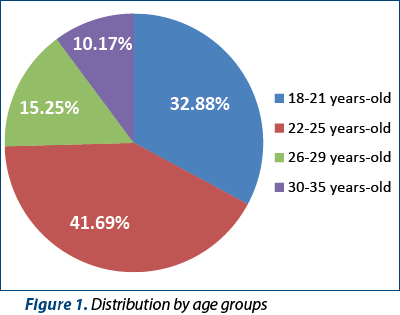
According to their residency, 67 people (22.71%) were from the rural environment, and 228 people (77.29%) were from the urban environment.
Second-section results
Among the 295 participants, 290 people (98.3%) used at least one social media platform. The 290 people were divided according to the average use of these platforms, as follows: less than 2 hours – 29 people (10%); 2-4 hours – 76 people (26.21%); 4-6 hours – 81 people (27.93%); 6-8 hours – 53 people (18.28%); more than 8 hours – 51 people (17.59%).
Figure 2 presents the most frequent applications used by the participants. Among the most accessed applications, there were Instagram, used by 79.32% of participants, WhatsApp (70.85%), YouTube (69.49%), and Facebook (58.31%).
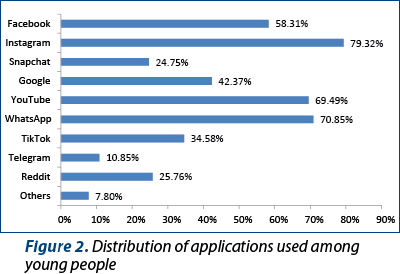
The average use of social networks before going to bed was also studied, obtaining the following data: less than 30 minutes – 70 people (23.73%); 30 minutes to 1 hour – 141 people (47.80%); 1-2 hours – 66 people (22.37%); more than 2 hours – 18 people (6.10%).
Through the Insomnia Severity Index, we highlighted the presence of insomnia in 19 people (10.17%).
At the question: “What do you think about the impact of using social media platforms on sleep?”, we got the following answers: “I do not consider that the use has any impact on sleep” (55 people; 18.64%); “I believe that the use of social media platforms improves the quality and/or quantity of sleep” (nine people; 3.06%); “I believe that the use of social networks has a negative impact on the quality of sleep” (155 people; 52.54%); “The use of social media platforms significantly reduces the quality and quantity of sleep” (76 people; 25.76%).
In the case of the statement “I try to use social media platforms less often”, we obtained the following answers: very rare – 15 people (5.08%); rare – 30 people (10.17%); sometimes – 131 people (44.41%); often – 85 people (28.81%); very often – 34 people (11.53%).
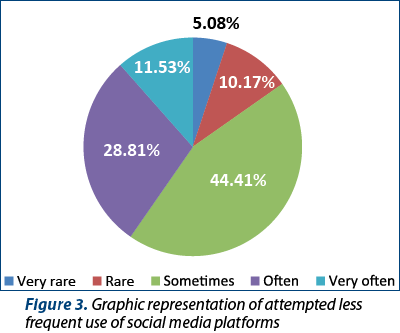
Third-section results
Table 1 presents the frequency with which the state of restlessness appeared depending on the frequency of using social networks as a source of information during the COVID-19 pandemic. Thus, social networks were used as a source of information as follows: very rare – 23 people (7.8%); rare – 38 people (12.88%); sometimes – 89 people (30.17%); often – 102 people (34.58%); very often – 43 people (14.58%).

After applying the Chi-squared test, we found out that there is a statistically significant association between the frequency of using social media as a source of information and the frequency of restlessness – Chi2=57.15; p<0.0001.
Analyzing the association between the frequency with which sleep was initiated with difficulty and the time spent on social media, we obtained, applying the Chi-squared test, a statistically significant value (p=0.0025).

We analyzed the association between the use of social media platforms before sleep and the quality of sleep. The data were divided into two groups: people who use social media less than 1 hour, respectively people who use social media more than 1 hour. Applying the Mann-Whitney test, we obtained a statistically significant result (p=0.0179).
In Table 3, we can see that the use of social media networks for more than 1 hour before starting sleep had a negative impact on the quality of sleep.

Fourth-section results
In Figure 4, we represented the average use of social media platforms according to the frequency of depressive states.
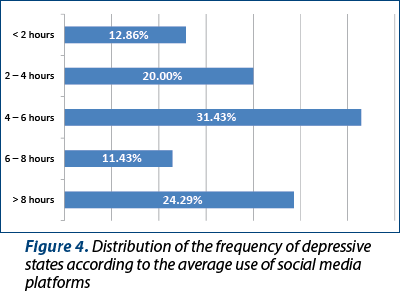
We analyzed and represented graphically the average use of social media platforms according to the frequency of anxious states (Figure 5) and according to the presence of states of fatigue and drowsiness (Figure 6).
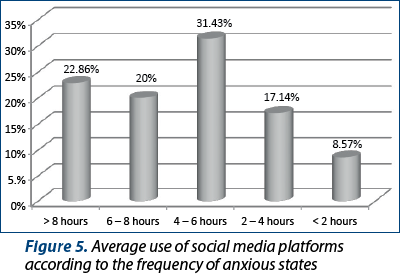
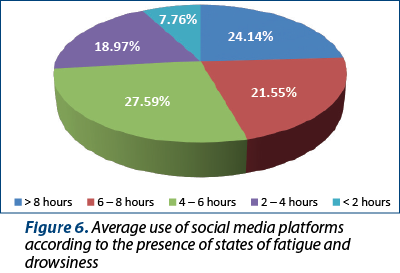
The analysis of the correlation between the time spent using social media before going to bed and the presence of insomnia highlighted a statistically significant difference when applying the Chi-squared test, with p<0.0001, the difference between the groups with and without insomnia disorder being represented in Table 4.
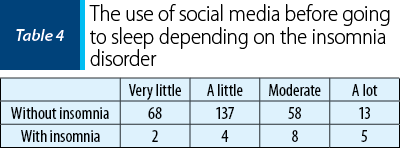
Figure 7 presents the association between difficulty initiating sleep after using social media and insomnia. Thus, we obtained p<0.0001, a statistically significant result.
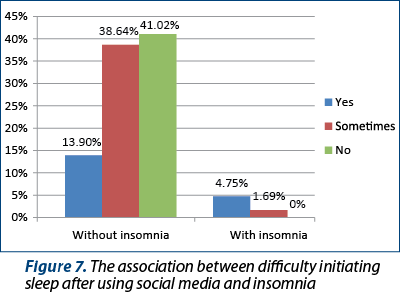
Based on the hypersomnia severity scale, adapted to the questionnaire, we highlighted the presence of hypersomnia in 25 people (8.47%).
We also highlighted the average use of social networks among people with hypersomnia. Thus, we obtained the following results: less than 2 hours – one person (4%); 2-4 hours – eight people (32%); 4-6 hours – eight people (32%); 6-8 hours – four people (16%); more than 8 hours – four people (16%).
In the case of people with hypersomnia, we obtained the following data regarding the time of using social media platforms before sleep initiation: less than 30 minutes – three people (12%); from 30 minutes to 1 hour – 12 people (48%); 1-2 hours – nine people (36%); more than 2 hours – one person (4%).
We analyzed the frequency of depressive states and the presence of hypersomnia disorder, and after applying the Chi-squared test, we obtained p=0.0295, a statistically significant result. The frequency of depressive states in people with hypersomnia was represented as follows: very rare – two people (8%); rare – three people (12%); sometimes – nine people (36%); often – seven people (28%); very often: four people (16%).
We also studied the association between the use of social networks before sleep initiation and sleep disorders. Applying the Chi-squared test, we obtained p=0.0013, a statistically significant result.
Following the association of the average use of social networks and the presence of sleep disorders, we obtained, after applying the Mann-Whitney test, p=0.043, a statistically significant result (Figure 8).
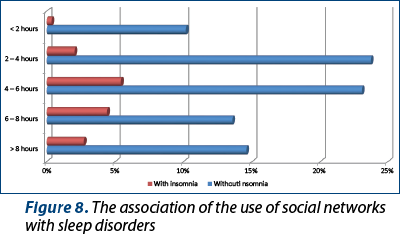
Discussion
Following the statistical analysis of the data obtained by distributing the questionnaire in the online environment, a statistically significant association was highlighted between the use for an increased number of hours of social media platforms and sleep disorders.
Even though self-assessment is a common method for statistical analysis, we must take into account the possibility that it may be affected by errors, which can influence the validity of the results obtained in this study, summing up to errors deriving from possible prejudices, deceptive self-assessments, or social desirability on the part of the participants(19).
A study conducted in 2015 suggested that the self-reporting of the time spent using the mobile phone is moderately true compared to reality, with most participants tending to underestimate the number of hours of use(20).
The basis of our study is the statistical analysis of a sample of 295 people aged between 18 and 35 years old, representative of the way of using social media platforms and for the presence of sleep disorders. Regarding the use of at least one social media platform, 98.3% answered positively, this fact being identified and concluded in other studies as well (21).
From the point of view of the average use of social media platforms among the participants, the predominant use was 4-6 hours/day (27.93%), the average per day being 4.98 hours, an increased average compared to the study conducted by Alwagait et al., where an average of 3.82 hours/day was obtained(22).
Evaluating the average use according to the age groups, it was highlighted that accessing social media platforms more than 8 hours a day is more frequent among people aged between 18 and 21 years old, and there is an inversely proportional relationship between the hours of use and age.
Another study reports that the use of at least 30 minutes of social media before sleep is associated with a higher prevalence of sleep disorders(17).
In this study, we highlighted the access of social media before sleep, along with its impact on sleep. The data showed that 76.27% of people use social media for at least 30 minutes. Regarding the association with sleep duration, it was observed that people with a sleep duration of 6-7 hours use social media at least 30 minutes before sleep.
At the same time, after dividing the participants into two groups, according to the use of social media before sleep (less than one hour and more than one hour), we obtained a statistically significant association, according to which the quality of sleep is significantly better in people who use social media less than one hour before sleep, compared to those who use more than one hour.
The data obtained highlighted a significant association between the excessive use of social media and the prevalence of difficulty initiating sleep, so that difficulty initiating sleep is more common in people who spend a lot of time on social networks.
The analysis of the opinion about the impact of the use of social media on sleep revealed that 78.3% of the people surveyed believe that there is a negative impact on sleep quality and that social media also reduces the quality and quantity of sleep, but 18.64% of the participants stated that there is no impact on sleep, the rest of the participants (3.06%) considering that it has a beneficial effect on sleep. The negative impact on sleep of the use of social media and electronic devices before sleep has also been suggested in other studies from abroad(22,23).
A statistically significant correlation was identified between the use of social media as a source of information during the COVID-19 pandemic and the presence of anxiety, frequent information predisposing to the appearance of anxious moods among the participants.
The quantification of depressive moods, fatigue and daytime sleepiness states, of anxious moods, according to the number of hours used on social media, revealed a predisposition to the presence of these states, being representative for social media users of at least 4 hours.
It has been statistically demonstrated that, following the use of social media, the difficulty of initiating sleep is representative of insomnia, compared to those without insomnia, although the difficulty of initiation is a determining factor of insomnia.
In the case of the average use of social networks among people with hypersomnia disorder, an increased prevalence was obvious among participants who accessed these networks for at least 4 hours.
The presence of depressive moods was studied in people with hypersomnia, in 44% of cases being frequently found, being significantly associated with the hypersomnia disorder. According to studies, in 90% of depression cases, sleep disorders are present, both insomnia and hypersomnia(24).
In this study, we analyzed both insomnia and hypersomnia as two extreme opposite aspects of the entire spectrum of sleep disorders. Following the association of the complex of sleep disorders with the average use of social networks, we obtained a statistically significant association, the predisposition to the development of a sleep disorder being characteristic for people who use social media platforms for an increased number of hours.
The negative effect on sleep of using social media before sleep initiation was also studied, observing a significant association. Accessing social media or devices at least 30 minutes before sleep represents a predisposing factor for the development of a sleep disorder, a fact highlighted in the literature(23).
Most of the research on the use of social media and its impact on sleep and mental health establish an important association between them. However, being cross-sectional studies, they do not allow the confirmation of a direct causal relationship. In the current literature, there is less focus on the potential positive influence on sleep.
Conclusions
Using social media platforms for an increased number of hours predisposes to the development of a sleep disorder, whether we are talking about insomnia or hypersomnia.
Addiction to social media is more relevant among younger people compared to older people.
The use of social media as a source of information during the COVID-19 pandemic was significantly associated with restlessness.
Difficulty initiating sleep after using social media is significantly associated with the presence of insomnia.
Accessing social networks for more than 30 minutes before sleepis associated with a decrease in sleep quality and with the presence of sleep disorders.
Among the participants, there is an increased prevalence of using social networks before going to bed.
Corresponding author: Elena-Gabriela Strete E-mail: elena.buicu@umfst.ro
CONFLICT OF INTEREST: none declared.
FINANCIAL SUPPORT: none declared.
This work is permanently accessible online free of charge and published under the CC-BY.

Bibliografie
-
Hall JE, Hall ME. Guyton and Hall Textbook of Medical Physiology. Elsevier, 2021, pp. 753-756
-
Grandner MA. Sleep, Health, and Society. Sleep Med Clin. 2020;15(2):319–40.
-
Zielinski MR, McKenna JT, McCarley RW. Functions and Mechanisms of Sleep. AIMS Neurosci. 2016;3(1):67-104.
-
Rasch B, Born J. About sleep’s role in memory. Physiol Rev. 2013;93(2):681-766.
-
Ackermann S, Rasch B. Differential Effects of Non-REM and REM Sleep on Memory Consolidation?. Curr Neurol Neurosci Rep. 2014;14(2):430.
-
Frank MG, Heller HC. The Function(s) of Sleep. In: Landolt HP, Dijk DJ (Editors). Sleep-Wake Neurobiology and Pharmacology (Internet). Cham: Springer International Publishing; 2018 (cited 2022 Nov 23). p. 3–34. (Handbook of Experimental Pharmacology; vol. 253).
-
Kryger MH, Roth T, Dement WC(Editors). Principles and practice of sleep medicine, Sixth Edition. Philadelphia, PA, Elsevier, 2017, 1730.
-
Lim J, Dinges DF. A meta-analysis of the impact of short-term sleep deprivation on cognitive variables. Psychol Bull. 2010;136(3):375–89.
-
Al Khatib HK, Harding SV, Darzi J, Pot GK. The effects of partial sleep deprivation on energy balance: a systematic review and meta-analysis. Eur J Clin Nutr. 2017;71(5):614–24.
-
American Psychiatric Association. DSM-5. Manual de Diagnostic şi Clasificare Statistică a Tulburărilor Mintale. Ed. Medicală Callisto, 2016.
-
The International Classification of Sleep Disorders Revised, 1997. In: Sleep Medicine Secrets (Internet). Elsevier, 2004 (cited 2022 Nov 30). p. 213–5. https://linkinghub.elsevier.com/retrieve/pii/B9781560535928500312
-
Alimoradi Z, Lin CY, Broström A, et al. Internet addiction and sleep problems: A systematic review and meta-analysis. Sleep Med Rev. 2019;47:51–61.
-
Pavlova MK, Latreille V. Sleep Disorders. Am J Med. 2019;132(3):292–9.
-
Trotti LM, Arnulf I. Idiopathic Hypersomnia and Other Hypersomnia Syndromes. Neurotherapeutics. 2021;18(1):20–31.
-
Abi-Jaoude E, Naylor KT, Pignatiello A. Smartphones, social media use and youth mental health. Can Med Assoc J. 2020;192(6):E136–41.
-
Levenson JC, Shensa A, Sidani JE, Colditz JB, Primack BA. The association between social media use and sleep disturbance among young adults. Prev Med. 2016;85:36–41.
-
Levenson JC, Shensa A, Sidani JE, Colditz JB, Primack BA. Social Media Use Before Bed and Sleep Disturbance Among Young Adults in the United States: A Nationally Representative Study. Sleep. 2017;40(9):zsx113.
-
Papagiouvanni I, Kotoulas S, Vettas C, Sourla E, Pataka A. Sleep During the COVID-19 Pandemic. Curr Psychiatry Rep. 2022;24(11):635–43.
-
Althubaiti A. Information bias in health research: definition, pitfalls, and adjustment methods. Journal of Multidisciplinary Healthcare. 2016;9:211–217.
-
Andrews S, Ellis DA, Shaw H, Piwek L. Beyond Self-Report: Tools to Compare Estimated and Real-World Smartphone Use. PLoS One. 2015;10(10):e0139004.
-
Smith A, Anderson M. A majority of Americans use Facebook and YouTube, but young adults are especially heavy users of Snapchat and Instagram. https://www.pewresearch.org/internet/2018/03/01/social-media-use-in-2018/
-
Alwagait E, Shahzad B, Alim S. Impact of social media usage on students’ academic performance in Saudi Arabia. Comput Hum Behav. 2015;51:1092–7.
-
Abdalqader MA, Ariffin IA, Ghazi HF, AboBakr MF, Fadzil MA. Prevalence of Insomnia and Its Association with Social Media Usage among University Students in Selangor, Malaysia, 2018. Folia Medica Indones. 2018;54(4):289.
-
Soehner AM, Kaplan KA, Harvey AG. Prevalence and clinical correlates of co-occurring insomnia and hypersomnia symptoms in depression. J Affect Disord. 2014;167:93–7.